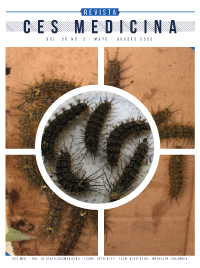Nutritional status and physical capacities in children 5-15 years - sports initiation centers; Urabá - Antioquia
DOI:
https://doi.org/10.21615/cesmedicina.6578Keywords:
child, physical fitness, exercise test, nutrition assessment, overweight, obesityAbstract
Objective: to evaluate the nutritional status and physical capacities in children and young people between 5-15 years in the subregion Urabá antioquieño. Methods: descriptive epidemiological study. Population: 3380 Users of the Sports Initiation and Training Centers (CIFD) - Indeportes Antioquia. Data collection: 2017-2018. For the analyzes, the subjects were grouped into three areas: 1) “Eje Bananero” 2) “North of Urabá” and, 3) “South of Urabá”. Age groups considered: 1) Infant (5 to 8 years); 2) Prepubescent (9-12 years old); and 3) Adolescents (≥13 years old). Results: the global prevalence of overweight was 13 % (higher in girls). obesity was present in 6.3 % of individuals. thinness was found in 11.4 %. in physical condition by age, the best results were presented in adolescents. It was found in the speed test (30 meters), a median between 5.7 and 6.7 seconds. In power (horizontal jump), a median between 1.1 and 1.6 meters (without differences with international references). In the abdominal test, a median between 16 and 21 repetitions. The physical tests by zones did not show important differences in: 30 meters stopped; 30 meters thrown; 50 meters released; jump and sit-ups. In the 600-meter test, the best result was found in “South of Urabá” with a median of 2.3 minutes (IR: 1.6 - 3.2). In the launch of the ball, the best result was found in the “Eje Bananero” with a median of 18.8 meters (IR: 14.5 - 24.5). Conclusion: a standardized battery to evaluate the nutritional status and physical condition of boys and girls (5-15 years old) allows a scientific approach for characterization, comparison with international standards and orientation of actions.
Downloads
References
Andersen L, Harro M, Sardinha L,et al. Physical activity and clustered cardiovascular risk in children: a cross-sectional study (The European Youth Heart Study). The Lancet. 2006; 368(9532): 299–304.
Zahner L, Muehlbauer T, Schmid M, Meyer U, Puder JJ, Kriemler S. Association of sports club participation with fitness and fatness in children. Med Sci Sports Exerc. 2009; 41(2): 344–50.
Iannotti RJ, Wang J. Trends in physical activity, sedentary behavior, diet, and BMI among US adolescents, 2001-2009. Pediatrics. 2013; 132(4): 606–14.
Gray C, Gibbons R, Larouche R, Sandseter EBH, et al. What Is the Relationship between Outdoor Time and Physical Activity, Sedentary Behaviour, and Physical Fitness in Children? A Systematic Review. Int J Environ Res Public Health. 2015; 12(6): 6455–74.
Goldfield GS, Harvey A, Grattan K, Adamo KB. Physical activity promotion in the preschool years: A critical period to intervene. Int J Environ Res Public Health. 2012; 9(4): 1326–42.
Janssen I, Leblanc AG. Systematic review of the health benefits of physical activity and fitness in school-aged children and youth. Int J Behav Nutr Phys Act. 2010; 7: 40: 1-16.
U.S. Department of Health and Human Services. 2008 Physical activity guidelines for Americans. Atlanta (GA): Office of Disease Prevention and Health Promotion, Centers for Disease Control and Prevention. 2008. Hallado en: http://health.gov/paguidelines/guidelines/
Organización Mundial de la Salud. Recomendaciones Mundiales sobre Actividad Física para la Salud. Ginebra, Suiza. 2010.Hallado en: https://www.paho.org/hq/dmdocuments/2012/OMS-Recomendaciones-mundiales-salud-2010.pdf
Ling JY, Robbins LB, McCarthy VL, Speck BJ. Psychosocial Determinants of Physical Activity in Children Attending Afterschool Programs A Path Analysis. Nurs Res. 2015; 64(3): 190–9.
Burke RM, Meyer A, Kay C, Allensworth D, Gazmararian JA. A holistic school-based intervention for improving health-related knowledge, body composition, and fitness in elementary school students: an evaluation of the HealthMPowers program. Int J Behav Nutr Phys Act. 2014; 11(1): 1-12.
Faigenbaum AD, Bush JA, McLoone RP, Kreckel MC, Farrell A, Ratamess NA, et al. Benefits of strength and skill-based training during primary school physical education. J Strength Cond Res. 2015; 29(5): 1255–62.
Bustamente A, Beunen G, Maia J. Valoración de la Aptitud Física en Niños y Adolescentes: Construcción de Cartas Percentílicas para la Región Central del Perú. Rev Peru Med Exp Salud Publica. 2012; 29(2): 188–97.
WHO AnthroPlus for personal computers Manual: Software for assessing growth of the world's children and adolescents. Geneva: WHO, 2009 (http://www.who.int/growthref/tools/en/).
Colombia. Ministerio de la Protección Social. Resolución 2121 de 2010 Por la cual se adoptan los Patrones de Crecimiento publicados por la Organización Mundial de la Salud, OMS, en el 2006 y 2007 para los niños, niñas y adolescentes de 0 a 18 años de edad y se dictan otras disposiciones.2010
Foresto WM. Efectos del entrenamiento de 3 vs 3 y 6 vs 6 en espacio reducido, en jóvenes futbolistas del Club Atlético River Plate. Revista Electrónica De Ciencias Aplicadas Al Deporte. 2013; 6(22):1-6.
KD Tambalis, DB Panagiotakos, Arnaoutis LS. Endurance, explosive power and muscle strength in relation to Body Mass Index and physical fitness in Greek children aged 7 to 10-y-old. Pediatr Exerc Sci. 2013;25(3):394-406.
Saint-Maurice P, Laurson K, Kaj M, Csányi T. Establishing Normative Reference Values for Standing Broad Jump Among Hungarian Youth. Res Q Exerc Sport. 2015; 86: S37–44.
Kovac M, Strel J, Jurak G, Leskosek B. Morphological Characteristics and Motor Fitness Among Girls Attending Different Secondary-School Programmes. Int J Morphol. 2012; 30(2): 411–6.
Delgado Floody P, Caamano Navarrete F, Cresp Barria M, et al. Nutritional Condition of Schoolchildren and Their Association With Levels of Fitness and Cardiovascular Risk Factors. Nutr Hosp. 2015; 32(3): 1036-41.
Navarrete F, Delgado Floody P. Bajos niveles de rendimiento físico, VO2 Max y elevada prevalencia de obesidad en escolares de 9 a 14 años de edad. Nutr Hosp 2016 Sep 20; 33(5): 1045-51.
Gulías González R, Sánchez López M, Olivas Bravo Á, et al. Physical fitness in spanish schoolchildren aged 6-12 years: Reference values of the battery EUROFIT and associated cardiovascular risk. J Sch Health. 2014; 84(10): 625-35.
Nassif H, Sedeaud A, Abidh E, Schipman J, et al. Monitoring fitness levels and detecting implications for health in a French population: an observational study. BMJ. 2012; 2(5): 1-8.
Ortega FB, Artero EG, Ruiz JR, España Romero V, Jiménez Pavón D, et al. Physical fitness levels among European adolescents: the HELENA study. Br J Sports Med. 2011; 45(1): 20–9.
Rivera JÁ, De Cossío TG, Pedraza LS, Aburto TC, et al. Childhood and adolescent overweight and obesity in Latin America: a systematic review. Lancet Diabetes Endocrinol. 2014 Apr; 2(4): 321-32.
Chomtho S, Fewtrell MS, Jaffe A, Williams JE, Wells JCK. Evaluation of arm anthropometry for assessing pediatric body composition: Evidence from healthy and sick children. Pediatr Res. 2006; 59(6): 860–5.
Aida Souki NA, Prieto C, Pérez Jiménez F, Valero D P, Amell A. Asociación de la resistina con variables de dimensión y composición corporal en eutróficos y obesos. Rev Med Chile. 2016; 144: 307-16.
Heyward V SL. Applied body composition assessment. Chap 6. In: Body composition and children. Human Kinetics; 1996. p. 90-8.
Rona RJ, Sundin J, Wood P, Fear NT. Agreement between body mass index, waist circumference and skin-fold thickness in the United Kingdom Army. Ann Hum Biol. 2011 May; 38(3): 257-64.
Downloads
Published
How to Cite
Issue
Section
License
Copyright (c) 2022 CES Medicina

This work is licensed under a Creative Commons Attribution-NonCommercial-ShareAlike 4.0 International License.
Derechos de reproducción (copyright)
Cada manuscrito se acompañará de una declaración en la que se especifique que los materiales son inéditos, que no han sido publicados anteriormente en formato impreso o electrónico y que no se presentarán a ningún otro medio antes de conocer la decisión de la revista. En todo caso, cualquier publicación anterior, sea en forma impresa o electrónica, deberá darse a conocer a la redacción por escrito.
Plagios, duplicaciones totales o parciales, traduccones del original a otro idioma son de responsabilidad exclusiva de los autores el envío.
Los autores adjuntarán una declaración firmada indicando que, si el manuscrito se acepta para su publicación, los derechos de reproducción son propiedad exclusiva de la Revista CES Medicina.
Se solicita a los autores que proporcionen la información completa acerca de cualquier beca o subvención recibida de una entidad comercial u otro grupo con intereses privados, u otro organismo, para costear parcial o totalmente el trabajo en que se basa el artículo.
Los autores tienen la responsabilidad de obtener los permisos necesarios para reproducir cualquier material protegido por derechos de reproducción. El manuscrito se acompañará de la carta original que otorgue ese permiso y en ella debe especificarse con exactitud el número del cuadro o figura o el texto exacto que se citará y cómo se usará, así como la referencia bibliográfica completa.
| Article metrics | |
|---|---|
| Abstract views | |
| Galley vies | |
| PDF Views | |
| HTML views | |
| Other views | |



